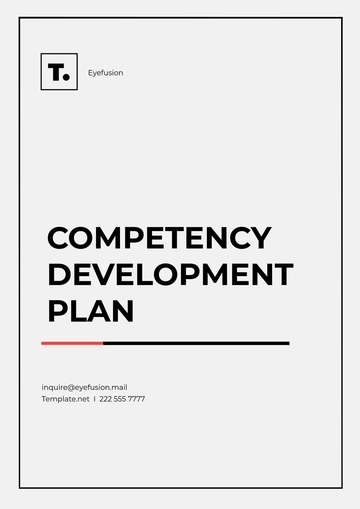Free Law Firm Development Plan

I. Executive Summary
The Law Firm Development Plan outlines our strategic vision and objectives for achieving sustainable growth and success in the legal market. It identifies key areas of focus and actionable initiatives to enhance client service, expand our practice areas, optimize operational efficiency, and strengthen our competitive position. With a commitment to innovation, client-centricity, and continuous improvement, we aim to position [Your Company Name] as a trusted advisor and partner for our clients' legal needs.
II. Introduction
Welcome to the Law Firm Development Plan for [Your Company Name]. Established in [Year], our firm has built a solid reputation for excellence in legal services, integrity, and professionalism. This plan represents our collective effort to chart a course for the future, leveraging our strengths and addressing challenges to drive sustainable growth and success. It reflects our commitment to strategic planning, collaboration, and adaptability in a dynamic legal landscape.
III. Firm Overview
Background
[Your Company Name] was founded in [Year] by [Founder(s) Name(s)], with a vision to provide exceptional legal counsel and personalized service to clients. Over the years, we have grown into a [Size] firm with a team of [0] lawyers and [00] support staff, serving clients across [Location(s)] in diverse industries and practice areas.
Organizational Structure
Our firm operates under a [Organizational Structure], with [00] partners leading various practice areas and departments. Our leadership team is comprised of seasoned professionals with extensive experience in their respective fields, guiding the firm's strategic direction and fostering a culture of collaboration and excellence.
IV. Environmental Analysis
SWOT Analysis
Strengths | Weaknesses |
|---|---|
Established reputation and brand recognition | Limited geographic reach |
Highly skilled and experienced legal team | Reliance on traditional marketing channels |
Strong client relationships and referral network | Need for improvement in technology infrastructure |
Opportunities | Threats |
|---|---|
Growth opportunities in emerging practice areas | Intense competition from larger firms |
Expansion into new geographic markets | Economic downturns impacting client demand |
Leveraging technology to enhance efficiency and client service | Regulatory changes affecting industry dynamics |
Analysis
Our SWOT analysis reveals that while we possess significant strengths such as an established reputation and skilled team, we face challenges related to geographic reach and technology infrastructure. However, there are ample opportunities to capitalize on emerging practice areas and leverage technology to improve efficiency. We must also remain vigilant to external threats such as competition and economic fluctuations, adapting our strategies accordingly.
V. Strategic Goals and Objectives
Strategic Goals
Expand Practice Areas: In response to market trends and client needs, we aim to diversify our practice areas to offer a broader range of legal services. By expanding into new practice areas such as employment law, environmental law, and cybersecurity, we can attract new clients and deepen our relationships with existing ones.
Enhance Client Service: Our goal is to prioritize client satisfaction by delivering exceptional service tailored to their specific needs. We will achieve this by implementing a client feedback program to gather insights and address any areas for improvement promptly. By exceeding client expectations, we aim to build long-lasting relationships and foster loyalty.
Improve Operational Efficiency: To remain competitive and maximize profitability, we are committed to streamlining our internal processes and leveraging technology effectively. By investing in automation tools, case management systems, and workflow optimization, we can reduce administrative overhead and free up resources to focus on delivering value-added services to our clients.
Strengthen Brand Presence: Building a strong brand presence is essential for attracting new clients and differentiating ourselves in the marketplace. Through targeted marketing campaigns, thought leadership initiatives, and strategic partnerships, we will increase our visibility and credibility within our target industries and geographic markets.
Objectives
Increase revenue from new practice areas by 20% within two years: This objective involves identifying opportunities for growth in emerging practice areas and implementing targeted business development strategies to attract clients in those areas.
Implement client feedback program to enhance satisfaction and loyalty: By collecting feedback from clients on their experiences with our firm, we can identify areas for improvement and make adjustments to our service delivery accordingly.
Streamline internal processes to reduce overhead costs by 15%: Improving operational efficiency will not only reduce costs but also enhance our ability to deliver services more effectively and responsively to our clients.
Launch targeted marketing campaigns to increase brand visibility and recognition: By developing compelling marketing messages and utilizing various channels such as digital advertising, social media, and industry events, we will raise awareness of our firm's capabilities and expertise.
VI. Practice Area Analysis
Current Practice Areas
Litigation: Our litigation practice encompasses a wide range of disputes, including commercial litigation, employment disputes, and intellectual property litigation.
Corporate Law: We provide comprehensive legal services to businesses of all sizes, including entity formation, contract negotiation, mergers and acquisitions, and corporate governance.
Real Estate: Our real estate practice assists clients with transactions, leasing, financing, and development projects across various sectors.
Intellectual Property: We advise clients on protecting and enforcing their intellectual property rights, including patents, trademarks, copyrights, and trade secrets.
Growth Opportunities
Employment Law: With the increasing complexity of employment regulations and workplace issues, there is a growing demand for legal services in this area. By expanding our expertise in employment law, we can assist clients with compliance, litigation, and risk management related to employment matters.
Environmental Law: Environmental regulations and sustainability concerns are becoming increasingly important for businesses across industries. By offering legal services in environmental law, we can help clients navigate regulatory requirements, mitigate environmental risks, and achieve their sustainability goals.
Cybersecurity and Data Privacy: With the proliferation of data breaches and privacy concerns, cybersecurity and data privacy have emerged as critical areas of focus for businesses. By providing legal counsel on data protection laws, cybersecurity best practices, and incident response strategies, we can help clients safeguard their sensitive information and mitigate legal risks.
Priorities
Allocate resources to develop expertise in employment law: This involves investing in training and professional development for our lawyers, as well as hiring experienced attorneys with expertise in employment law to bolster our capabilities in this area.
Explore opportunities to expand services in environmental law: We will conduct market research to identify potential clients and industries that require legal assistance in environmental matters. Additionally, we will seek partnerships and collaborations with environmental consultants and organizations to enhance our service offerings.
VII. Client Development and Retention
Client Analysis
Key Industries: Our clients come from diverse industries, including technology, healthcare, finance, manufacturing, and more. Understanding the unique needs and challenges of each industry allows us to provide tailored legal solutions that meet our clients' objectives.
Client Demographics: Our client base includes multinational corporations, small and medium-sized enterprises (SMEs), startups, entrepreneurs, and individuals. By catering to a diverse range of clients, we can leverage our expertise and resources to deliver value-added services that address their specific needs.
Strategies
Strengthen client relationships through regular communication and engagement: We will prioritize open and transparent communication with our clients, providing regular updates on their matters and seeking feedback to ensure their needs are met. By fostering strong relationships built on trust and reliability, we can position ourselves as trusted advisors and partners to our clients.
Identify opportunities for cross-selling and upselling services: By understanding our clients' businesses and industries, we can identify additional legal needs and opportunities to provide complementary services. By proactively offering value-added services, we can deepen our relationships with clients and maximize revenue opportunities.
VIII. Business Development and Marketing
Marketing Strategies
Digital Marketing: We will leverage digital channels such as our website, social media platforms, and email marketing to reach and engage our target audience effectively. By creating compelling content, optimizing our online presence, and utilizing targeted advertising campaigns, we can raise awareness of our firm and attract potential clients.
Networking: Building and maintaining professional relationships is key to business development. We will actively participate in industry events, conferences, and networking groups to connect with potential clients, referral sources, and strategic partners. By networking effectively, we can expand our reach and generate new business opportunities.
Thought Leadership: Establishing ourselves as thought leaders in our practice areas enhances our credibility and visibility in the marketplace. We will publish thought leadership content such as articles, whitepapers, and webinars to showcase our expertise, share insights, and address relevant legal issues. By demonstrating our knowledge and expertise, we can attract potential clients and reinforce our reputation as trusted advisors.
IX. Talent Management and Professional Development
Recruitment
Attract top legal talent through targeted recruitment efforts: We will actively recruit experienced attorneys and legal professionals who align with our firm's values, culture, and practice areas. By offering competitive compensation packages, opportunities for career advancement, and a supportive work environment, we can attract and retain top talent in the industry.
Training and Development
Provide ongoing training and professional development opportunities: We are committed to investing in the growth and development of our lawyers and staff. Through training programs, continuing education, and mentorship initiatives, we will empower our team members to enhance their skills, expand their knowledge, and excel in their respective roles.
Diversity and Inclusion
Promote diversity and inclusion initiatives: We recognize the value of diversity in fostering innovation, creativity, and inclusivity within our firm. We will implement diversity and inclusion programs to ensure equal opportunities for all employees, regardless of race, gender, ethnicity, sexual orientation, or background. By fostering a diverse and inclusive workplace culture, we can attract a wider talent pool, enhance employee engagement, and better serve our clients' diverse needs.
X. Operational Efficiency and Technology
Process Improvement
Conduct process mapping exercises: We will analyze our existing workflows and processes to identify areas for improvement and optimization. By streamlining our internal procedures, eliminating redundancies, and standardizing best practices, we can increase efficiency, reduce errors, and enhance the overall quality of our services.
Technology Investments
Upgrade technology infrastructure: We will invest in modern technology solutions to support our firm's operations and enhance productivity. This includes upgrading our case management system, implementing cloud-based collaboration tools, and adopting automation software to streamline administrative tasks and workflows. By leveraging technology effectively, we can improve communication, collaboration, and service delivery, ultimately enhancing the client experience.
XI. Financial Management and Growth
Financial Analysis
Review financial performance metrics: We will regularly monitor key financial indicators such as revenue, expenses, profitability, and cash flow. By conducting in-depth financial analysis, we can identify trends, opportunities, and areas for improvement to ensure the long-term financial health and sustainability of our firm.
Budgeting
Develop a detailed budget: We will create a comprehensive budget aligned with our strategic goals and growth objectives. This includes allocating resources strategically, setting financial targets, and monitoring expenses to ensure efficient use of financial resources while supporting our firm's growth and development initiatives.
Growth Strategies
Explore merger and acquisition opportunities: We will evaluate potential merger and acquisition opportunities to expand our geographic reach, diversify our service offerings, and enhance our market position. By partnering with complementary firms or acquiring niche practices, we can achieve economies of scale, access new clients and markets, and accelerate our growth trajectory.
Invest in marketing and business development: We will allocate resources to marketing and business development initiatives aimed at increasing brand awareness, generating leads, and acquiring new clients. This includes investing in targeted marketing campaigns, digital advertising, and client relationship management tools to attract prospective clients and drive revenue growth.
XII. Implementation Plan
Action Steps
Establish cross-functional teams: We will form cross-functional teams comprising representatives from different practice areas and departments to oversee the implementation of key initiatives. These teams will be responsible for executing action plans, tracking progress, and addressing any challenges or roadblocks that may arise.
Timelines and Milestones
Define timelines and milestones: We will establish clear timelines and milestones for each initiative, outlining specific tasks, deadlines, and deliverables. By setting realistic timelines and tracking progress against milestones, we can ensure that initiatives stay on track and are completed in a timely manner.
Monitoring and Evaluation
Monitor progress and evaluate results: We will implement monitoring and evaluation mechanisms to track the progress and effectiveness of our development plan. This includes regular reviews, performance metrics, and feedback mechanisms to assess the impact of initiatives, identify areas for improvement, and make necessary adjustments to achieve our goals.
XIII. Risk Management and Contingency Planning
Risk Identification
Identify potential risks and challenges: We will conduct a comprehensive risk assessment to identify potential internal and external risks that may impact the success of our development plan. This includes risks related to market conditions, regulatory changes, competitive pressures, and internal factors such as resource constraints or organizational culture.
Risk Mitigation
Develop contingency plans: We will develop contingency plans and risk mitigation strategies to address identified risks and minimize their impact on our firm's operations and objectives. This may involve implementing safeguards, establishing alternative courses of action, or reallocating resources to manage risks effectively while maintaining our focus on achieving our strategic goals.
Compliance
Ensure compliance with legal and regulatory requirements: We will stay informed about relevant laws, regulations, and industry standards that may affect our firm's operations and development initiatives. By maintaining compliance with applicable legal and regulatory requirements, we can mitigate legal and reputational risks, protect our firm's interests, and uphold the trust and confidence of our clients and stakeholders.
XIV. Conclusion
In conclusion, the Law Firm Development Plan provides a strategic roadmap for achieving our firm's goals and objectives. By focusing on talent management, operational efficiency, financial management, and risk mitigation, we can position ourselves for sustainable growth and success in a competitive legal landscape. Through collaboration, innovation, and a commitment to excellence, we are confident that we can achieve our vision and fulfill our mission of delivering exceptional legal services to our clients.
- 100% Customizable, free editor
- Access 1 Million+ Templates, photo’s & graphics
- Download or share as a template
- Click and replace photos, graphics, text, backgrounds
- Resize, crop, AI write & more
- Access advanced editor
Organize your law firm's growth strategy effortlessly with the Law Firm Development Plan Template from Template.net. This editable and customizable template empowers you to tailor your strategic roadmap to perfection. Utilize the AI Editor Tool to streamline your planning process and achieve sustainable success. Elevate your firm's competitiveness and efficiency with this comprehensive solution.





























